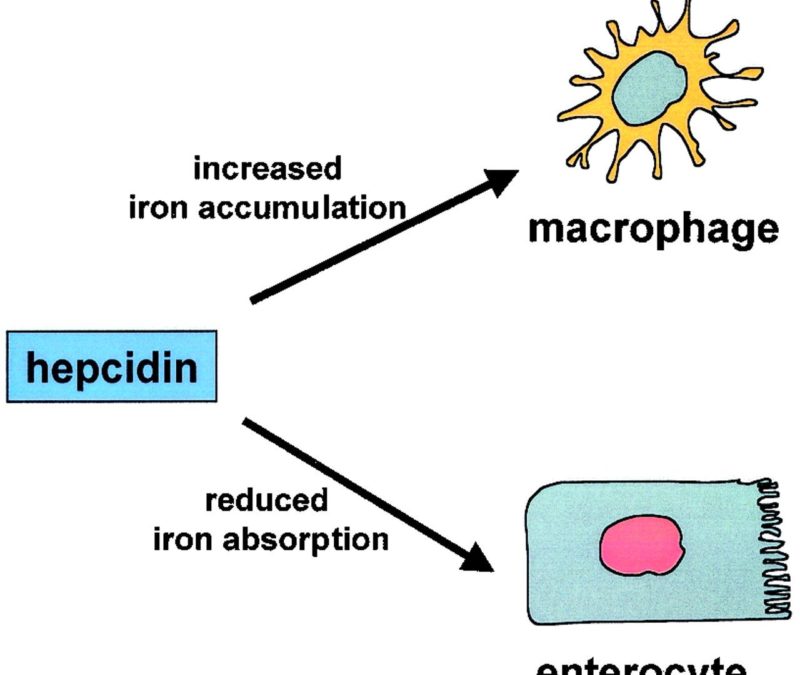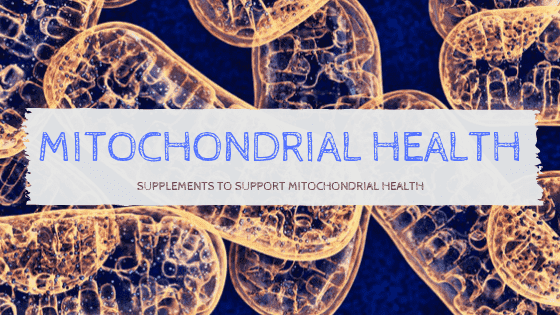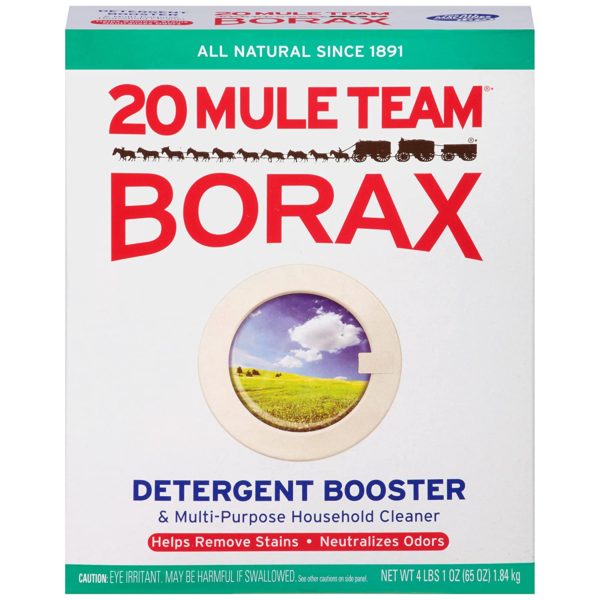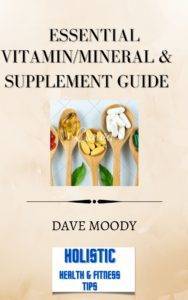Hepcidin Overview
What is hepcidin and why should we care? If you suffer from iron deficiency, toxicity, iron poor blood anemia and other peripherally related issues, stay tuned and learn about this little-known peptide.
Hepcidin is now acknowledged to be the main iron regulatory hormone produced in our bodies. It is a 25-amino acid peptide exclusively synthesized by the liver initially identified in a search for novel antimicrobial peptides.1 There was no indication that it had an additional role in iron metabolism until 2001 when mouse studies discovered that hepatic hepcidin mRNA synthesis was induced by iron loading.2
Iron overload can lead to severe health problems such as heart failure, liver cancer and diabetes while deficiency can lead to anemia issues and more!
Hepcidin regulates the amount of iron absorbed by the gastrointestinal tract. When hepcidin levels are high, it leads to an imbalance with dietary iron consumption leading to ID – iron deficient anemia. This article discusses how hepcidin can be regulated to improve issues with iron absorption and reduce ID.
Iron is an essential nutrient required by the human body for carrying oxygen in the blood. It is found in meat, vegetables, and iron-fortified foods. Hepcidin can be regulated by meals made with phytates, which bind to the hepcidin and keep it from preventing iron absorption.
Phytic Acid and How it Relates to Hepcidin
Phytic acid is a six-fold dihydrogen phosphate ester of inositol, also called inositol hexakisphosphate or inositol polyphosphate. At physiological pH, the phosphates are partially ionized, resulting in the phytate anion. Wikipedia
Phytates (and phytic acid) are antioxidant compounds found in whole grains, legumes, nuts and seeds. The chief concern about phytates is that they can bind to certain dietary minerals including iron, zinc, manganese and, to a lesser extent calcium, and slow their absorption. However, the presence of phytates in foods really isn’t the worry that some individuals believe it to be.
The only individuals who might need to be careful are those who consume a lot of wheat bran, which is a concentrated source of these substances. Phytate-associated deficiencies of iron and zinc occur in some third-world countries where people mostly eat grains. Cooking reduces a food’s phytic acid content to some degree as does soaking whole grains prior for use in baking. To help this breakdown, you can soak them in yogurt, buttermilk, or water combined with lemon juice or vinegar.

More Foods with Phytic Acid that Affect Hepcidin
The highest concentrations of phytic acid are found in raw and unprocessed plant-based foods.
If your diet lacks nutrition or you have an iron or zinc deficiency, you should reduce the amount of phytic acid you consume.
Here are four foods high in phytic acid:
1. Beans
Most beans and legumes contain a high amount of phytic acid. However, studies have shown that soaking beans before eating them significantly reduces their phytate levels.
2. Seeds
When a plant is ripening, phytate rapidly accumulates in its seeds. Phytic acid is found in sesame seeds, linseeds, and sunflower seeds.
3. Nuts
Nuts naturally contain a high amount of phytic acid. The process of “activating” nuts by soaking them in water and then dehydrating them at a low temperature breaks down some of the phytic acid.
4. Grains
Grains contain phytic acid, but only if they haven’t been processed. Whole grains also contain lectins and saponins, which are two more anti-nutrients. However, products made with processed grains contain fewer healthy nutrients.
Phytic Acid-Free Preparation Options to Optimize Hepcidin
Many processes help destroy phytates before you even eat them. This includes:
- Sprouting
- Cooking
- Baking
- Processing
- Soaking
- Fermenting
- Yeast leavening
People who regularly consume high amounts of phytic acid — such as vegetarians and vegans — can benefit from eating mineral-absorbing enhancers like garlic and onions. These foods increase the absorption of minerals like iron and zinc.
WebMD
Phytates have some anti-inflammatory benefits. In laboratory research, phytates have helped normalize cell growth and stopped the proliferation of cancer cells. They may also help prevent cardiovascular disease and lower a food’s glycemic load. Andrew Weil, M.D.
Here are some phytate – hepcidin lowering/iron boosting foods followed by the phytate raising, iron lowering foods to consider:
1. Red meat
2. Soybeans
Incredibly high in iron, soybeans are also very versatile as they can be added to many dishes, or just eaten on their own. They are also low in fat and high in protein.
3. Spinach
A leafy green that contains a healthy amount of calcium, vitamins A, E, and C, spinach also has a great supply of iron. One cup of boiled spinach can cover approximately 20% of your body’s daily iron needs.
4. Beets
Filled with a good amount of iron.
5. Peanut butter
A terrific source of iron on its own, peanut butter can also easily be combined with other foods on this list.
6. Eggs
Eggs not only contain a decent amount of iron, but they are also filled with antioxidants and vitamins that are helpful to your body.
7. Nuts
8. Honey
Every 100 grams of honey is approximately 0.42 mg of iron.
Foods Affecting Hepcidin that Should be Avoided if Anemic
1. Phytate-Rich Foods
Phytates can reduce iron absorption into the bloodstream. Legumes and certain whole grains are good examples.
2. Tannins
Much like phytate-rich foods, foods that contain tannins can also interfere with the body’s ability to absorb iron. Foods that contain tannin include coffee, green tea, black tea, grapes, and wine.
3. Gluten
Some sufferers of anemia may also have issues with gluten. If you have a gluten intolerance of any sort, gluten can cause problems but with your digestive system and also prevent the intestines from absorbing iron and folic acid properly. Pasta, barley, wheat, grains, and oats should be avoided if this is the case.
4. Calcium-Rich Foods
Calcium can also interrupt the absorption of iron by the body. Dairy products like milk, yogurt, and cheese should be avoided for this reason.
5. Alcohol
The consumption of alcohol should be curbed, if not outright stopped, as it interferes with the absorption of folate for those with folate-deficiency anemia.
Fruits High in Iron
1. Watermelon
Watermelon is high in iron, but it’s also high in vitamin C. The vitamin C is a great bonus as it can help the body absorb the iron better.
2. Prunes
Prunes contain a good amount of iron; in fact, one cup of prunes can contain 4.5 mg of iron. Prune juice is also a good option as 8 ounces of prune juice contains much more iron than the equivalent amount of beef.
3. Raisins
Despite the fact that grapes should be avoided, their dried brother, the raisin, is good for an anemic diet. One cup of seedless raisins gives you about 3 mg of iron.
4. Currants
A cup of currants will net you 2 mg of iron, but if you dry those currants out, that number goes up to 5 mg, according to Livestrong.
Most of the fruits are dried or appear to have more iron per cup when dried.
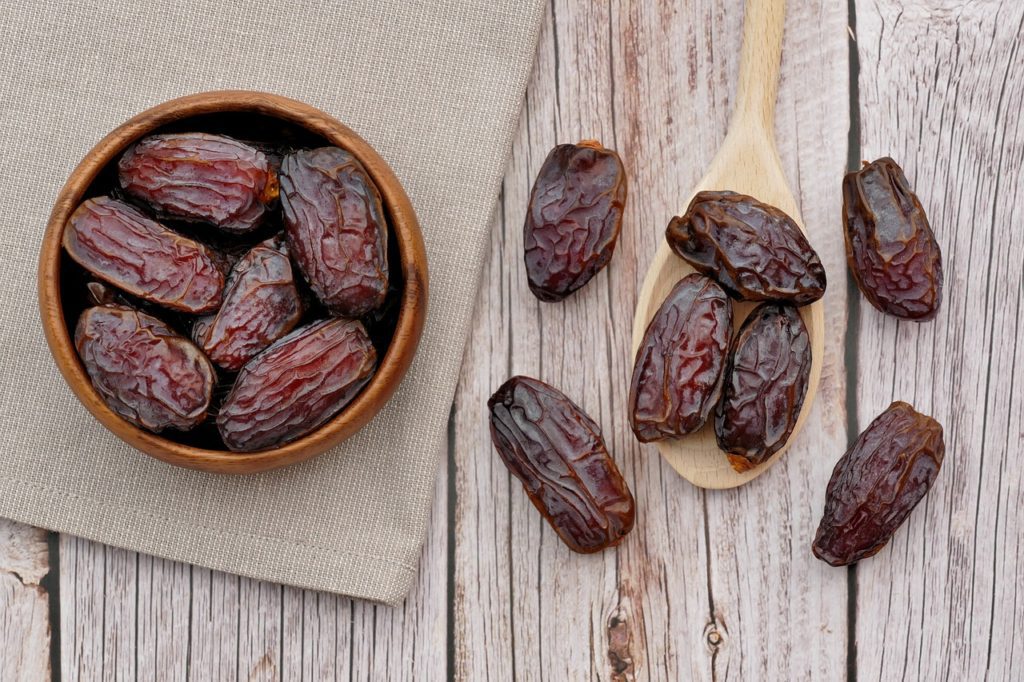
Hepcidin Dysregulation Factors
Back to hepcidin and more on how it regulates iron. In a perfect world, it is suppressed when iron is low and at high levels when iron is too high. As we discussed, phytates can impact the ability of hepcidin to function optimally as well as other potential substances but the research is still very new and inconclusive outside of the known phytate interaction and the following factors.
The following information has been excerpted from anemiacentral.com, a leading source for ID and all things to do with anemia.
Hepcidin remains high despite high iron levels in the following circumstances:
- Infection
- Inflammation
- Certain liver tumors that cause anemia
- Certain genetic predispositions
- Exercise
- Vitamin D Deficiency reduces iron Absorption
- Taking iron pills – (taking conventional ferritin pills)
Notice that the last circumstance on the list that causes hepcidin levels to rise and to allow the body to absorb less iron is taking iron pills! Unfortunately for those who are iron deficient, taking iron pills actually leads to a rise in hepcidin and a decrease in the amount of iron absorbed. Even with one iron pill, hepcidin begins to increase. There is an alternative below.
Pretty mind-blowing data from anemiacentral.com!
Other Factors that Decrease Hepcidin
- Epogen- a hormone made famous by Lance Armstrong. It’s used frequently in cancer patients and those with serious kidney problems to help them produce more red blood cells.
- High Altitude Living
- Lack of Oxygen (which is why altitude works)
- Carbon Monoxide Poisoning 7
- Vitamin D. Even one supplementary dose can decrease hepcidin by up to 35%. Vitamin D and Iron. 8
- Reducing inflammation in the body
- Low iron levels
Sorry, Don’t Count on Your Doctor for Hepcidin Info
Doctors are reportedly out of touch on this information in general and causing patients to become even more iron deficient by prescribing ferritin supplementation! Taking it multiple times a day is even worse according to anemia central and each day of supplementation contributes to higher and higher hepcidin levels, exacerbating the problem! Who knew?
So, we sort of know what not to do and what to look out for but it appears that this hepcidin stuff is not doing such a great job or maybe we are over reacting and trying to control something that nature needs to dictate? The following are some of the known factors that decrease hepcidin.
Reading up on Vitamin D and Iron and how Vitamin C Improves Iron Absorption are imperative subjects to research.
Hold the Presses!
Wow, that really dated me but I need your attention as there is another type of iron that actually plays well with hepcidin after all! Good news so please remove your lips from that exhaust pipe on your Honda and listen up.
Liposomal iron technology reportedly can avoid rocking the hepcidin boat while replenishing iron deficiency! It is being used by athletes and others to bolster the ID blood while side stepping the hepcidin predicament!
They offer this at anemiacentral.com and I noticed that other online supplement stores also sell the liposomal versions. They apparently do not require vitamin C with this technology so yet another benefit in the absorption process. Great news so check it out!
Incredible information! This author knew of vitamin C boosting iron absorption and some of the competing minerals that hinder absorption but the vast majority that anemiacentral.com has presented is stunning and nearly unknown to the masses and so-called experts!
Our thanks for this ground breaking insight from anemiacentral.com Please visit them for more details on this important information on hepcidin and iron regulation!
Two hormones that control hunger

